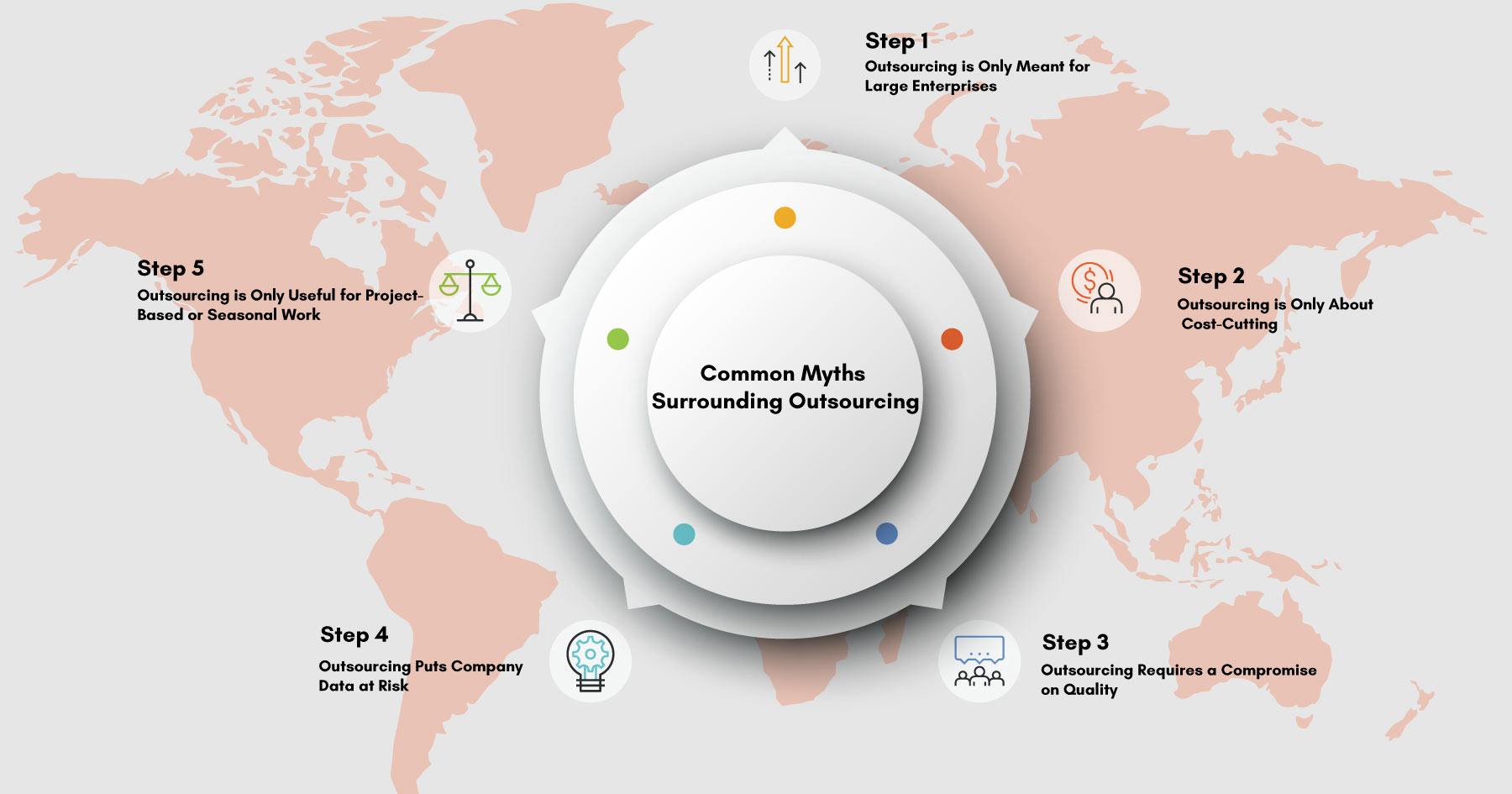We recently recorded a live stream on the topic of busting myths about outsourcing. While outsourcing has become a popular topic of discussion with today’s economic climate and labor challenges, some firms are hesitant to engage an outsourcer, often due to misconceptions held since the early days of outsourcing.
Based on our research and interviews, we know that the outsourcing journey can be full of anxiety, particularly for first-time outsourcers. In this blog, we will address some common outsourcing myths and misperceptions. This recap is based on the live stream with Dave Shapiro, a 30-year industry veteran in outsourcing, and chief operating officer at Premier BPO.
Common Myths Surrounding Outsourcing

Myth 1 – Outsourcing is Only Meant for Large Enterprises
Reality:
Outsourcing started with large corporations such as AT&T, Chase, and Apple, but now many midsize and even small companies take advantage of the cost savings and quality that outsourcing brings. Nearly all companies have some form of cloud-based technology integrated into their infrastructure which helps leverage a global talent pool. This makes it easier for midsize companies to outsource functions. Initially, companies needed fifty or a hundred full-time employees (FTEs) to outsource, but now they can get value even with as few as five or ten.
Myth 2 – Outsourcing is Only About Cost-Cutting
Reality:
Outsourcing is indeed good for cost-savings and many companies start it to induce the very same, due to economic requirements. However, quality of work becomes the main driver for many organizations to stay and continue growing their outsourcing relationship. They may start with a small number of employees, but as quality improves, companies slowly move up the outsourced functions, both in terms of size and complexity. In many cases, the quality of work produced through outsourcing ends up exceeding what the company was capable of doing internally. This also leads to increased innovation and growth opportunities for the company. Cost should not be the decision-making factor when choosing the right outsourcing partner. Dedication to quality should be the focus, cost will improve as an after-effect automatically.
Myth 3 – Outsourcing Requires a Compromise on Quality
Reality:
Most companies believe outsourcers just replicate processes without any improvement; therefore, quality isn’t as good as what is produced in-house. The opposite is true in the case of many outsourcing BPOs and Co-sourcing partners like Premier BPO. It is the type of relationship built with an outsourcing partner that defines the output received.
Lifting and shifting a process to replicate functions is a norm for outsourcers. Once they understand the client’s unique methodology, they also contribute to process improvements. These can come in the form of recommendations for the client, or from the outsourcing provider’s side. Whereupon, the outsourcer will apply methodologies such as Lean Six Sigma and Pareto Analysis, which in turn lower handle time, and improve customer satisfaction (CSAT) and net promoter score (NPS) for clients. In many cases, outsourcing leads to better results than what was possible for a company to do internally.
Myth 4 – Outsourcing Puts Company Data at Risk
Reality:
Outsourcing organizations go to great lengths to acquire PCI certifications, GDPR compliances, and multi-factor authentications. These are necessary security measures that ensure client data security. The data and customer information stay on the client’s cloud systems or server, never leave the US, and cannot be downloaded or stored in any way. Data can be updated or edited, but all is done remotely with technology today. So, the client’s data is treated the same as someone working from a branch office, securely, as if the client were to provide access to someone in internal operations. With an outsourcing partner, it is better, as they have specialized expertise and resources dedicated to security.
Myth 5 – Outsourcing is Only Useful for Project-Based or Seasonal Work
Reality:
Early on when Outsourcing began, it was often used as a solution for handling seasonal work or spikes in workload and recalls. Which justifies project-based work models for the time being. However, maintaining a team on an ongoing basis has many benefits such as: being equipped to handle any upcoming short-term projects, having established connectivity, and understanding of culture, and management mentality on the outsourcer’s end. Keeping a small offshore team even after a project ends, helps speed up the learnings for future seasons or ongoing processes.
Summary:
- Outsourcing is no longer a leverage afforded only to large enterprises, midsize and small companies can also avail the benefits it brings
- Cost cutting should not be the main factor considered when outsourcing; relationship building and quality should be prioritized
- Outsourcing can improve the quality of work if the outsourcing partner is aligned with your goals and is proactive in giving process improvement suggestions
- Data security concerns can be addressed by having a contract that defines data handling and checking the compliance of the outsourcing partner
- Outsourcing can be a long-term solution if the right partner with a Co-source mentality is chosen.
Frequently Asked Questions and Common Myths About Outsourcing:
Myth – Outsourcing is Too Complicated to Manage
Reality:
If your outsourcing partner has a detailed and formalized implementation plan then there are no complications. Premier BPO helps clients such as First-Time Outsourcers walk through all necessary steps such as training curriculum, IP connectivity, process documentation, etc. to help them acclimatize. We, as the outsourcing partner, make the transition smoother for the client due to experience. We guide each client through the process to make it easy, while we become a seamless extension of their business.
Myth – Offshoring and Outsourcing Are the Same
Reality:
Offshoring and Outsourcing are often used interchangeably but are very different in terms of application. Outsourcing can be done domestically or offshore, whereas Offshoring can be done with an outsourcer or in a captive situation. In the latter, employees work for the company directly, like in the example of Chase Bank which had 10,000 employees, all in captive. They are Chase employees and work for them. Some companies outsource domestically and offshore, but it is important to know the difference, based on individual requirements.
Additionally, organizations should not have preconceived notions when deciding to outsource. Rather they should adopt a right-shoring strategy. Observe where the best fit and value for skills and cost come from for a particular function. Different countries excel in certain areas, such as tech support or customer service outsourcing. Some tasks should be only done domestically, such as licensed agent positions in the insurance industry. The decision to outsource should be based on the function and need, not pre-judgment of a certain location.
Myth – Outsourcing Can Cause Communication Problems
Reality:
Communication can mean various things, such as language or business understanding. English has become a very accepted language worldwide and most countries work in U.S. time zones. From any location, outsourcing teams work during all U.S hours so clients are accommodated 24/7. Premier BPO has formalized communication in the forms of documents, flowcharts, and daily, weekly, and monthly touch bases. All our agents are trained for active listening and empathic and clear communication. Similar to Franklin Covey’s mantras, we seek to understand first in order to be understood. Hence, we proactively handle any communication issues that might arise.
Myth – Outsourcing Means You Lose Control of Your Business
Reality:
Previously firms would just hand over the outsourcing work and expect results. Premier BPO acts as an extension of the client’s team by applying dedicated resources, giving them total control and insight. We help free up the client’s time so they don’t have to manage the day-to-day work, and can focus on strategy and higher-level business decisions.
Watch the live stream recording of our webinar Chapter 1 here:
https://www.linkedin.com/events/mythbustersregardingoutsourcing7048765678694055936/comments/
Have Concerns About Outsourcing? We Can Help!
 Skip to content
Skip to content





